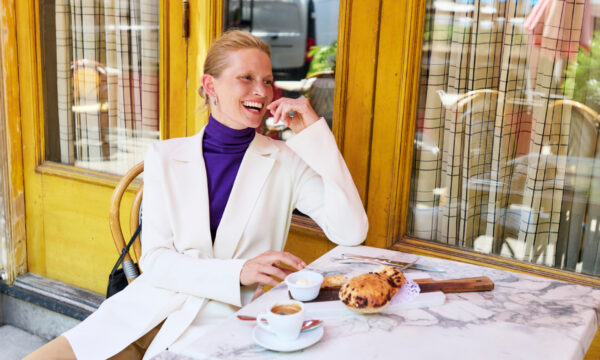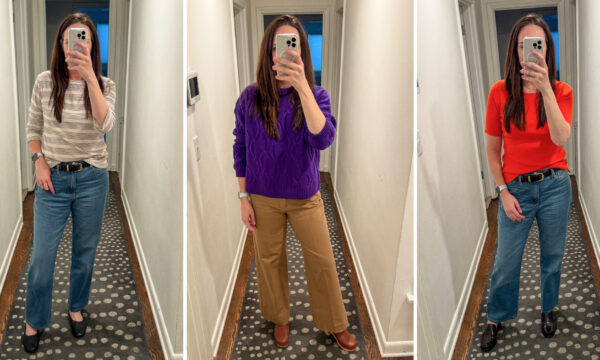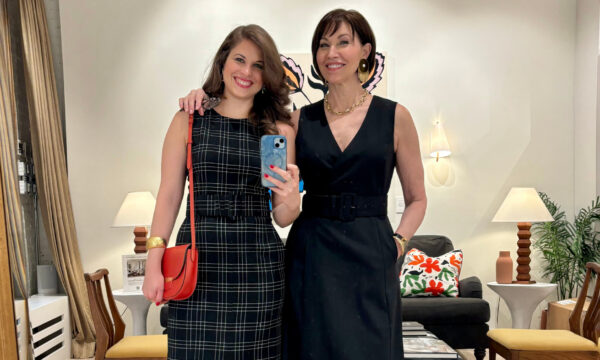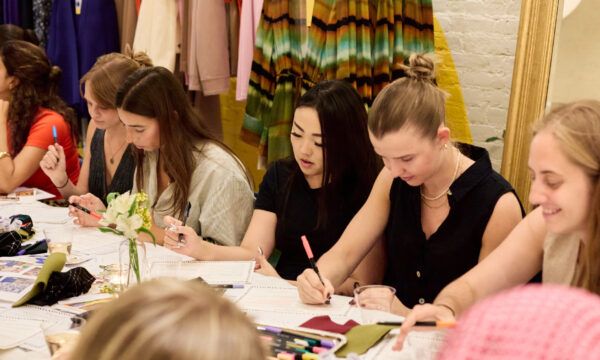
Image credit: the American Cancer Society
Dressing with Confidence in the Face of Breast Cancer
Two survivors share their experiences.
In honor of Breast Cancer Awareness Month, we’ve teamed up with the American Cancer Society to offer the M.M.LaFleur community new opportunities to support their important work. As part of this partnership, we got to speak with two inspiring women, Amanda McCrimlisk and Jenny Saldaña, about their experiences with breast cancer, how those experiences have shaped their style, the things they want everyone to understand about cancer, and more. Click here to learn how you can help support the ACS, and read on for their reflections.
Want more M Dash?
Sign up for our weekly newsletter.
Thank you!
Their Stories
Amanda McCrimlisk, 39, is a Senior Manager of Corporate Relations at the American Cancer Society. She’s also a breast cancer survivor; but her own diagnosis isn’t why she wanted to work for the ACS. “I got involved in nonprofits years ago, because my grandmother passed away from breast cancer at 55 in the early ’80s,” she explains. Amanda received her diagnosis in late 2023, a year after giving birth. “I was just coming out of the newborn stage and noticed something odd in my left breast,” she says. “It wasn’t a lump, but I felt pain and a pulling. I dismissed it as something related to nursing.” By the end of the month, after visiting a friend who had undergone a double mastectomy for early-stage breast cancer, she decided to get checked. Her OB recommended a mammogram and ultrasound due to her family history.
Concern kicked in when she returned for a follow-up mammogram. “I knew that something was wrong, because the faces around me had changed,” she says. “I left with a weird feeling. When people tell their story, you always hear them say, ‘When I heard I had cancer,’ or, ‘When I heard those words.’ For me, there were no words. I read it in my chart.” Amanda turned to her brother-in-law, who is an interventional radiologist, to help decode her chart. “My mammogram came back with a very high BI-RAD score, which is where they rate your tumor based on its likelihood of malignancy,” she explains. “Mine was the highest it could be. I had ER positive, HER-II negative breast cancer. That means my cancer was fueled by estrogen and progesterone, which is the most common type of breast cancer.”
Since then, Amanda has had a double mastectomy and 14 rounds of chemo. As of our conversation, she was seven weeks out from her last treatment. “I like to think I’m cancer free,” she says. “But no one’s actually said those words to me, so I’m kind of still in this limbo.”
“I feel that my job as a survivor and an advocate is to hold the hand of those people and tell them that I'm going to walk with them.”
New York City native Jenny Saldaña is an actor, writer, and stand-up comic, who also manages a walking food tour company. She first felt a lump in her right breast when she was just 33. Right away, she consulted her OBGYN. “He told me, ‘Oh no, you’re fine. You just have lumpy breasts,’” recalls Jenny. “The lump kept getting bigger, and I kept going back, and they kept telling me, ‘No, no, no, you’re very young. You don’t have a family history. You don’t have the BRCA gene.’ They just kept dismissing me.”
After reaching the point where her right breast was significantly larger than my left one and she had a nipple discharge, her gynecologist finally sent her to a diagnostic office, where she was, again, dismissed. “They said, verbatim, ‘If it’s not bloody, we don’t care. You can’t keep coming in here and taking up resources from women who actually need them,’” Jenny shares. “At the time, I had a nice mid-level job at Procter and Gamble. I’m college educated, and I’m bilingual. I had resources, and they were still throwing me away. I thought, ‘What about women who don’t have the resources that I had?’ It went on like that for another year. Finally, I said, ‘I can’t take it anymore. I don’t care if it’s a diamond. Could we please take it out?’ That’s when I was referred to New York Presbyterian Hospital, and I was finally biopsied and given a mammogram.”
On the same day when she would eventually be diagnosed, Jenny’s first mammogram was a false negative. “That’s why it’s very important to have any follow-up tests that your doctor may suggest, or even to ask if they did an ultrasound,” she explains. “I was diagnosed on January 4th, and I was under the knife on January 25th. Even though I had stage one breast cancer, I had to have a mastectomy because of the size of the tumor.”
This is Jenny’s 18th year of being cancer-free, and in that time, she’s used her experience to educate and support others. “I’ve been very grateful to the American Cancer Society for allowing me to be a face of cancer for a lot of people in the Latin community,” she says. “People have called me their cancer madrina, which means godmother. I take that very seriously, because I feel that my job as a survivor and an advocate is to hold the hands of those people and tell them that I’m going to walk with them.”
Their Style
Jenny has always loved fashion, but going through chemotherapy made style an even larger part of her life. “During treatment, I fell in love with scarves,” she says. “I would wear my Chanel scarf like designer hair, and I would match it with my outfits. I believe in the Coco Chanel saying, ‘Dress shabbily and they remember the dress; dress impeccably and they remember the woman.’ So when I was going through my recovery, dressing well was very important to me. My breasts were a very big part of my identity—not so much my sexuality—but of how I identified as an attractive woman.”
Throughout her recovery, Jenny found that expressing her style allowed her to feel more like herself. “Fashion played a big part in finding my new normal,” she says. “It was important to me to look healthy. I can’t explain that, but anybody who’s been sick knows—it’s important to you. If you feel good, you look good, and you dress well, it helps your mood. It helps everything.”
Today, style remains a big part of Jenny’s life. Her go-to pieces include fun jackets, a large collection of little black dresses, and fabulous glasses chains. And for a finishing touch, she adds a swipe of red lipstick. “I never leave the house without it,” she says.
“During treatment, there were times when I would put an outfit on in my house by myself, because when I felt put-together, I felt better.”
Amanda echoes that going through chemo made style more important than ever before. “I’ve never worn more makeup in my life than I did during the chemo process,” she says. “With losing my hair, I felt like I needed to jazz up the rest of my body. I didn’t want to look sickly—I wanted people to look at me and think, ‘Oh, she looks so great.’ It made me feel better to get dressed.”
In her wardrobe, Amanda prioritizes neutrals and is selective about the trends in which she participates. “I’m from New Jersey, and black is our go-to,” she explains. “We’re a very muted people. I’m a little more understated when it comes to my clothing, but I like to jazz it up with a shoe or jewelry. When it comes to trends, I stick with what works for my body. I’ll always go for a black jean, but I can’t go flare again, and I prefer a high waist. And I’m never going to wear a high sock.”
“There really is truth to the idea that when you look good, you feel good. During treatment, there were times when I would put an outfit on in my house by myself, because when I felt put-together, I felt better. I think I will take that with me moving forward.”
What They Wish People Understood About Cancer
Amanda emphasizes that cancer is different for everyone, and when it comes to supporting somebody, there’s no one-size-fits-all answer. “Personally, I’m very open about my story,” she says. “But I know other people with cancer who are much more private. When someone in your life has cancer, you have to meet them where they are and follow their lead. People have reached out to me, saying, ‘So-and-so has cancer, what should I do for them?’ And it’s really hard for me to answer that question, because I don’t know them.”
Both Amanda and Jenny also highlight the importance of doing rather than asking. “Don’t say, ‘What can I do for you?’ Just show up and do something,” says Amanda. “Don’t ask, because then you’re just putting more work on that person.” Jenny adds, “You need to call them. Don’t ask them to check in, because they’re busy with their full-time job of being sick.”
“While I think it's extremely important to have a good mental attitude, it's also important to feel your feelings and know that this sucks.”
Jenny mentions that pity will only make people feel worse. “I went to see my general practitioner a few months after I had my surgery,” she shares. “The nurse came in, and when she undid my robe, I still wasn’t fully reconstructed, so I didn’t have a nipple or an areola, and she just sighed and made a sad face. I wanted the ground to swallow me up.”
Both women also share the importance of avoiding toxic positivity. “If someone you love has cancer, it’s okay to be sad,” says Amanda. “While I think it’s extremely important to have a good mental attitude, it’s also important to feel your feelings and know that this sucks.” Jenny adds, “Often, someone without cancer will say, ‘You’ll be fine,’ or ‘Okay, but you’re here,’ and that diminishes how the person is feeling.”
Finally, understand that life after cancer comes with its own set of challenges. “Survivorship is a weird thing,” says Amanda. “I finished chemo about seven weeks ago, and I remember talking to somebody who was like, ‘Oh my god, aren’t you so excited?’ I thought, ‘Yeah, but then what?’ It’s a weird transition. What happens after? I wish that was talked about more.”
The Role of the American Cancer Society
Jenny’s first encounter with the American Cancer Society came soon after she began chemotherapy. “I happened to have a friend who was working there, and he got me two amazing wigs that I ended up never using,” she says. “Believe it or not, the wigs made me not feel like myself. You have this identity crisis when you’re going through cancer about wanting to look like yourself.” Eventually, the ACS would pave the way for Jenny to get a job at New York Presbyterian as the breast cancer patient navigator and the leader of the Spanish support group. She’s also since written a national award-winning play about her experience.
“The American Cancer Society has been able to help me help my community,” Jenny says. “I had resources, but most Latinas do not, and unfortunately, more Caucasian women will get diagnosed with breast cancer, but more minorities will die of breast cancer. It’s important to me to show my community that the face of breast cancer isn’t always over 40. By the time I was five years cancer-free, I was still too young for a mammogram according to the health standards in this country.”
Like Jenny, Amanda’s relationship with the ACS is both personal and professional. “Coming from the nonprofit world, the American Cancer Society is so well respected and well known that I always wanted to work here,” she says. “But on a personal level, I care about the work that they have done. My grandma was diagnosed in the late 1970s, at age 45, and I think if she were diagnosed today, she probably wouldn’t have died, because of the major advancements that have been made, largely due to the American Cancer Society.”
Jenny closes with some words of encouragement for anyone who may be on their own cancer journey: “It’s going to take you a long time to like yourself again, but you’ll like yourself so much more. Cancer has blessed me in ways that I cannot express. Do I wish these lessons had come another way, wrapped in another gift? Absolutely. But I’m grateful for who I am today because of cancer.”
Learn more about our partnership with the American Cancer Society here.










